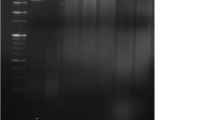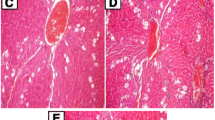Abstract
Coriandrum sativum (coriander) is an annual herb of the Apiaceae family and has been used as a traditional remedy. Here we examined whether heated leaf extract of coriander decreases the concentrations of heavy metals in tissues. Male ddY mice were given a drinking water containing 0.25% of heated leaf extract of coriander for 8 weeks. Eight weeks after the intake, the concentrations of zinc, iron, copper, arsenic, and cadmium were measured in the liver and kidney. The intake of coriander did not modify the concentrations of all heavy metals tested in the liver, but decreased the concentrations of iron, arsenic, and cadmium in the kidney. Because heavy metals can induce oxidative stress, the effect of coriander intake on hydrogen peroxide-induced oxidative stress was compared between slices from the kidney and liver. The slices were immersed in Ringer solution containing 100 μM hydrogen peroxide and aminophenyl fluorescein (APF), a probe for detecting reactive oxygen species (ROS). APF fluorescence was markedly increased in the control kidney slices, while the increase was completely blocked in kidney slices from coriander intake group. In contrast, APF fluorescence was also markedly increased in the control liver slices, while the increase was not blocked by coriander intake. The present study indicates that intake of coriander leaf extract contributes to powerful resistance to oxidative stress in the kidney, probably via decreased concentrations in heavy metals. It is likely that decrease in arsenic concentration to the detection limit is a major factor for the resistance.




Similar content being viewed by others
References
Chung RT (2017) Detoxification effects of phytonutrients against environmental toxicants and sharing of clinical experience on practical applications. Environ Sci Pollut Res Int 24:8946–8956. https://doi.org/10.1007/s11356-015-5263-3
Laribi B, Kouki K, M’Hamdi M, Bettaieb T (2015) Coriander (Coriandrum sativum L.) and its bioactive constituents. Fitoterapia 103:9–26. https://doi.org/10.1016/j.fitote.2015.03.012
Sahib NG, Anwar F, Gilani AH, Hamid AA, Saari N, Alkharfy KM (2013) Coriander (Coriandrum sativum L.): a potential source of high-value components for functional foods and nutraceuticals—a review. Phytother Res 27:1439–1456. https://doi.org/10.1002/ptr.4897
Gray AM, Flatt PR (1999) Insulin-releasing and insulin-like activity of the traditional anti-diabetic plant Coriandrum sativum (coriander). Br J Nutr 81:203–209. https://doi.org/10.1017/S0007114599000392
Cioanca O, Hritcu L, Mihasan M, Hancianu M (2013) Cognitive-enhancing and antioxidant activities of inhaled coriander volatile oil in amyloid β (1–42) rat model of Alzheimer’s disease. Physiol Behav 120:193–202. https://doi.org/10.1016/j.physbeh.2013.08.006
Al-Mofleh IA, Alhaider AA, Mossa JS, Al-Sohaibani MO, Rafatullah S, Qureshi S (2006) Protection of gastricmucosal damage by Coriandrum sativum L. pretreatment in Wistar albino rats. Environ Toxicol Pharmacol 22:64–69. https://doi.org/10.1016/j.etap.2005.12.002
Mani V, Parle M, Ramasamy K, Majeed AB (2011) Removal of memory deficits by Coriandrum sativum leaves in mice. J Sci Food Agric 91:186–192. https://doi.org/10.1002/jsfa.4171
Rakhshandeh H, Sadeghnia HR, Ghorbani A (2012) Sleep-prolonging effect of Coriandrum sativum hydro-alcoholic extract in mice. Nat Prod Res 26:2095–2098. https://doi.org/10.1080/14786419.2011.613388
Puthusseri B, Divya P, Lokesh V, Neelwarne B (2012) Enhancement of folate content and its stability using food grade elicitors in coriander (Coriandrum sativum L.). Plant Foods Hum Nutr 67:162–170. https://doi.org/10.1007/s11130-012-0285-1
Sharma V, Kansal L, Sharma A (2010) Prophylactic efficacy of Coriandrum sativum (coriander) on testis of lead-exposed mice. Biol Trace Elem Res 136:337–354. https://doi.org/10.1007/s11130-012-0285-1
Velaga MK, Yallapragada PR, Williams D, Rajanna S, Bettaiya R (2014) Hydroalcoholic seed extract of Coriandrum sativum (coriander) alleviates lead-induced oxidative stress in different regions of rat brain. Biol Trace Elem Res 159:351–363. https://doi.org/10.1007/s12011-014-9989-4
Aga M, Iwaki K, Ueda Y, Ushio S, Masaki N, Fukuda S, Kimoto T, Ikeda M, Kurimoto M (2001) Preventive effect of Coriandrum sativum (Chinese parsley) on localized lead deposition in ICR mice. J Ethnopharmacol 77:203–208. https://doi.org/10.1016/S0378-8741(01)00299-9
Karunasagar D, Krishna MV, Rao SV, Arunachalam J (2005) Removal and preconcentration of inorganic and methyl mercury from aqueous media using a sorbent prepared from the plant Coriandrum sativum. J Hazard Mater 118:133–139. https://doi.org/10.1016/j.jhazmat.2004.10.021
Omura Y, Beckman SL (1995) Role of mercury (Hg) in resistant infections & effective treatment of Chlamydia trachomatis and herpes family viral infections (and potential treatment for cancer) by removing localized hg deposits with Chinese parsley and delivering effective antibiotics using various drug uptake enhancement methods. Acupunct Electrother Res 20:195–229
Omura Y, Shimotsuura Y, Fukuoka A, Fukuoka H, Nomoto T (1996) Significant mercury deposits in internal organs following the removal of dental amalgam, & development of pre-cancer on the gingiva and the sides of the tongue and their represented organs as a result of inadvertent exposure to strong curing light (used to solidify synthetic dental fillingmaterial) & effective treatment: a clinical case report, along with organ representation areas for each tooth. Acupunct Electrother Res 21:133–160
Gaur N, Kukreja A, Yadav M, Tiwari A (2017) Assessment of phytoremediation ability of Coriander sativum for soil and water co-contaminated with lead and arsenic: a small-scale study. 3 Biotech:196. https://doi.org/10.1007/s13205-017-0794-6
Chakraborti D, Rahman MM, Mukherjee A, Alauddin M, Hassan M, Dutta RN, Pati S, Mukherjee SC, Roy S, Quamruzzman Q, Rahman M, Morshed S, Islam T, Sorif S, Selim M, Islam MR, Hossain MM (2015) Groundwater arsenic contamination in Bangladesh-21 years of research. J Trace Elem Med Biol 31:237–248. https://doi.org/10.1016/j.jtemb.2015.01.003
Rashid MH, Rahman MM, Correll R, Naidu R (2018) Arsenic and other elemental concentrations in mushrooms from Bangladesh: health risks. Int J Environ Res Public Health 15(5), pii:E919. https://doi.org/10.3390/ijerph15050919
Meharg AA, Raab A (2010) Getting to the bottom of arsenic standards and guidelines. Environ Sci Technol 44:4395e4399. https://doi.org/10.1021/es9034304
Meharg AA, Zhao FJ (2012) Arsenic and rice. Springer, Dordrecht. https://doi.org/10.1017/S0014479712000713
Meharg AA, Williams PN, Deacon CM, Norton GJ, Hossain M, Louhing D, Marwa E, Lawgalwi Y, Taggart M, Cascio C, Haris P (2014) Urinary excretion of arsenic following rice consumption. Environ Pollut 194:181–187. https://doi.org/10.1016/j.envpol.2014.07.031
Jomova K, Jenisova Z, Feszterova M, Baros S, Liska J, Hudecova D, Rhodes CJ, Valko M (2011) Arsenic: toxicity, oxidative stress and human disease. J Appl Toxicol 31:95–107. https://doi.org/10.1002/jat.1649
Jomova K, Valko M (2011) Advances in metal-induced oxidative stress and human disease. Toxicology 283:65–87. https://doi.org/10.1016/j.tox.2011.03.001
Wu X, Cobbina SJ, Mao G, Xu H, Zhang Z, Yang L (2016) A review of toxicity and mechanisms of individual and mixtures of heavy metals in the environment. Environ Sci Pollut Res Int 23:8244–8259. https://doi.org/10.1007/s11356-016-6333-x
Acknowledgements
This work was supported by Nishihara group Inc. (Mishima, Japan).
Author information
Authors and Affiliations
Corresponding author
Ethics declarations
Conflict of Interest
The authors declare no conflict of interest.
Additional information
Publisher’s Note
Springer Nature remains neutral with regard to jurisdictional claims in published maps and institutional affiliations.
Rights and permissions
About this article
Cite this article
Nishio, R., Tamano, H., Morioka, H. et al. Intake of Heated Leaf Extract of Coriandrum sativum Contributes to Resistance to Oxidative Stress via Decreases in Heavy Metal Concentrations in the Kidney. Plant Foods Hum Nutr 74, 204–209 (2019). https://doi.org/10.1007/s11130-019-00720-2
Published:
Issue Date:
DOI: https://doi.org/10.1007/s11130-019-00720-2




